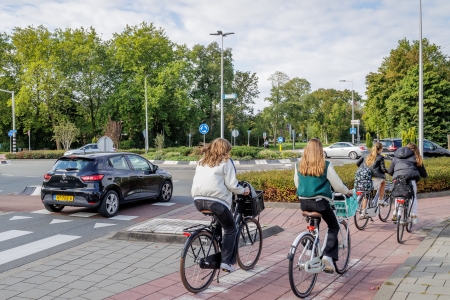Infrastructural measures
Infrastructural measures for pedestrians and cyclists, provided they are properly applied, are effective for all road users, and thus for young ones as well. The negative development of bicycle-only crashes, for example crashes with bollards, argues for improved infrastructure layout [38]. Keeping young road users in mind, safe school routes could be a first contribution. For more information, see SWOV fact sheet Infrastructure for pedestrians and cyclists.
Bicycle helmets
Bicycle helmets protect cyclists from head and brain injuries. In the Netherlands, most touring cyclists wear bicycle helmets, but in ordinary traffic hardly anyone does. Research [39] among youngsters aged 12 to 24 shows that 78% of them never wear helmets. Weijermars et al. [40] have studied the potential casualty reduction if all cyclist were to wear helmets all of the time. Although young cyclists are not mentioned separately, what does become apparent is that the number of road deaths would decrease by 85 and the number of serious road injuries by 2500-2600, if all cyclists wore helmets all of the time. Proven results in Denmark show that it is feasible to substantially increase the percentage of bicycle helmet use without any coercion or mandatory helmet wear [41].
For more information, see SWOV fact sheet Bicycle helmets.
Training
There are some indications that resilience training and hazard recognition training work for young road users [15]. This could also be done using Virtual Reality (VR). By means of VR training, primary school pupils aged 9 to 12 practised safe road user behaviour while cycling or walking. The evaluation showed that children’s road user skills improve by practising in a VR environment. However, the children’s level of retention is unknown, nor do we know whether they were able to put into practice what they had learned [42]. Resilience training for young car drivers, from the age of 17 onwards, appears to have reduced crash risk in Australia, including crash risk in the dark [43] [44]. Hazard recognition training also seems to affect Situational Awareness [45]. More research into the learning capacities of youngsters could result in training programmes that are tailor-made and that take their strengths and weaknesses into account [46].
